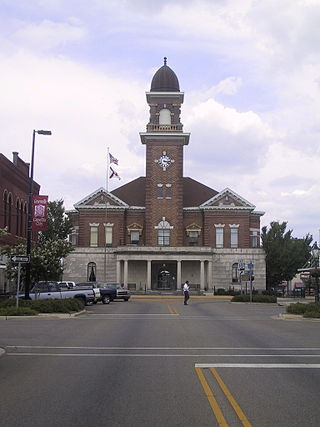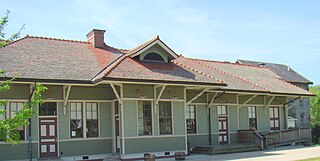
Butler County is a county located in the south central portion of the U.S. state of Alabama. As of the 2020 census, the population was 19,051. Its county seat is Greenville. Its name is in honor of Captain William Butler, who was born in Virginia and fought in the Creek War, and who was killed in May 1818.

Greenville is a city and the county seat of Butler County, Alabama, United States. At the 2020 census, the population was 7,374. Greenville is known as the Camellia City, wherein originated the movement to change the official Alabama state flower from the goldenrod to the camellia with legislative sponsors LaMont Glass and H.B. Taylor.

Helena is a city in Jefferson and Shelby counties in the state of Alabama. Helena is considered a suburb of Birmingham and part of the Birmingham-Hoover Metropolitan Area. As of 2022 the United States Census Bureau estimates the population to be 21,862.

Portland is a city in Sumner and Robertson counties in Tennessee. The population was 11,486 in 2010 according estimates by the U.S. census bureau and in 2020 the population was 13,156. Portland is a part of the Nashville Metropolitan Statistical Area.

Greer is a city in Greenville and Spartanburg counties in the U.S. state of South Carolina. The population was 35,308 as of the 2020 census, making it the 14th-most populous city in South Carolina. Greer is included in the Greenville-Anderson-Greer, SC Metropolitan Statistical Area, which is part of the Greenville-Spartanburg-Anderson, SC Combined Statistical Area in Upstate South Carolina.
Antioch is a neighborhood of Nashville located approximately 12 miles (19 km) southeast of Downtown Nashville. It is served by the Metropolitan Government of Nashville and Davidson County.

The Louisville and Nashville Railroad, commonly called the L&N, was a Class I railroad that operated freight and passenger services in the southeast United States.
Parksville is a small unincorporated community on the Chaplin River in south central Boyle County, Kentucky, United States. It is located at the eastern end of Ky Route 300, where it intersects with Ky Route 34, near the US Post Office. The global position of Parksville is 37.597N latitude and -84.891W longitude. Elevation is 1,083 feet (330 m) above sea level. Current population is approximately 900 people. The ZIP Code for Parksville is 40464.

Toney is an unincorporated community in the northwestern part of Madison County, Alabama, United States. It is part of the Huntsville-Decatur Combined Statistical Area. According to "Appointment of Postmasters, 1832 - September 30, 1971" from the National Archive, the post office was established in 1898. Blanche Rawls Toney was the first post master, and Toney is said to have been named in her honor, probably by James E. Toney, her husband.
The Louisville and Nashville Depot, or Louisville and Nashville Railroad Depot or Louisville and Nashville Passenger Station, Louisville and Nashville Railroad Passenger Depot or variations, may refer to the following former and active train stations previously used by the Louisville and Nashville Railroad. Some of these are listed on the National Register of Historic Places (NRHP).

Cordova is a community in Shelby County, Tennessee, United States. Cordova lies east of Memphis, north of Germantown, south of Bartlett, and northwest of Collierville at an elevation of 361 feet.

Stanford L&N Railroad Depot, also known as Baughman's Mill and Stanford Railroad Depot, is a historic train depot located in Stanford, Kentucky. It was built in 1911 and was used by the Louisville and Nashville Railroad.
A Mississippi Landmark is a building officially nominated by the Mississippi Department of Archives and History and approved by each county's chancery clerk. The Mississippi Landmark designation is the highest form of recognition bestowed on properties by the state of Mississippi, and designated properties are protected from changes that may alter the property's historic character. Currently there are 890 designated landmarks in the state. Mississippi Landmarks are spread out between eighty-one of Mississippi's eighty-two counties; only Issaquena County has no such landmarks.

The North Alabama Railroad Museum, Inc. is a railroad museum in Huntsville, Alabama. The museum, incorporated in 1966, is an all volunteer organization. The museum has a collection of rolling stock, a small train station, and a small heritage railroad called the Mercury and Chase Railroad which operates between April and December. The mission of the NARM is to "preserve railroad history in North Alabama and South Central Tennessee." It is run entirely by its 100-plus volunteers. The museum is open to the public daily, volunteers are usually available on Wednesdays and Saturdays. Admission to the museum is free, however there is a charge for riding the trains. A schedule of rides is available at the museum's website.
Manistee is an unincorporated community in Monroe County, Alabama, United States. Manistee was a logging town, and was home to the Manistee Mill Company, Bear Creek Mill Company and Runyan-Burgoyne Lumber Company. The Manistee Mill Company built a spur track to connect the sawmills of Manistee with the Louisville & Nashville Railroad in Repton and named it the Manistee & Repton Railway. The railway began operations in 1907 and remained in use until the 1970s, operating over 45 miles of track. Amasa Coleman Lee, father of Harper Lee, served as financial manager for a Monroeville law firm's interests in the Manistee & Repton Railway. A post office was operated in Manistee from 1892 to 1912.
Bemiston is an unincorporated community and former company town in Talladega County, Alabama, United States. Bemiston now lies within the city limits of Talladega.
Longwood is an unincorporated community in Brunswick County, North Carolina, United States. The community is located on North Carolina Highway 904, 8.6 miles (13.8 km) north of Sunset Beach. Longwood has a post office with ZIP code 28452.

The Wadley Railroad Depot is a historic train station in Wadley, Alabama. The depot was built in 1907 along with the Atlanta, Birmingham, and Atlantic Railroad line as part of an expansion from West Point, Georgia, to Talladega, Alabama. The Callaway Corporation, who operated numerous textile mills along the Chattahoochee River and later founded Callaway Gardens, purchased the land that would later become the town of Wadley, intending to build a mill in the town. The deal fell through before the mill was built, but the town continued as a local agricultural trading hub. The station closed to passenger traffic in 1964, and the line eventually came under the control of CSX Transportation.
Covin, also known as Brockton or Tallula, is an unincorporated community in Fayette County, Alabama, United States.

Chinnabee, also spelled Chinneby or Chinnibee, is an unincorporated community in Talladega County, Alabama, United States.















